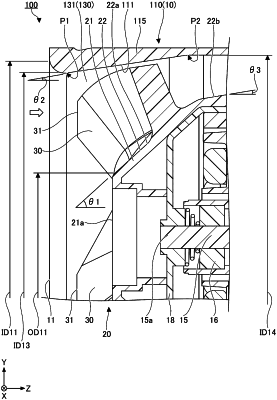| CPC F04D 29/542 (2013.01) [F04D 19/002 (2013.01); F04D 25/0606 (2013.01)] | 17 Claims |

|
1. A fan comprising:
a casing that includes an air inlet and an air outlet, and in which a flow path communicating from the air inlet to the air outlet is formed;
an impeller that is disposed in the casing and rotatable about an axis, the impeller including
a hub portion disposed at an air inlet side,
a plurality of rotor blades formed on the hub portion, each of the plurality of rotor blades including a leading edge and a trailing edge, and
a cylindrical portion that extends from the hub portion to an air outlet side, and forms a flow path between the cylindrical portion and the casing; and
a plurality of fixed blades that extend, in a radial direction, from an inner circumferential surface of the casing toward an outer circumferential surface of the cylindrical portion of the impeller, wherein
the casing includes an increasing diameter portion having an inner circumferential surface that increases in inner diameter from the air inlet side toward the air outlet side,
a maximum outer diameter of the plurality of rotor blades is larger than a minimum inner diameter of the increasing diameter portion,
a position of the minimum inner diameter of the increasing diameter portion is located, in an axial direction, at the air inlet side of a position of the maximum outer diameter of the plurality of rotor blades,
the plurality of rotor blades project, in the axial direction, beyond the hub portion toward the air inlet,
a length of the plurality of fixed blades in the axial direction is longer than a width of the plurality of fixed blades along the radial direction, and
a camber line of each rotor blade of the plurality of rotor blades is located closer to the air outlet than a blade chord that is defined as a linear distance between the leading edge and the trailing edge of the rotor blade.
|